Dubai, UNITED ARAB EMIRATES — A global rush for the next wave of generative artificial intelligence is increasing public scrutiny on an often-overlooked but critically important environmental issue: Big Tech’s expanding water footprint.
Tech giants, including the likes of Microsoft and Alphabet-owned Google, have recently reported a substantial upswing in their water consumption and researchers say one of the main culprits is the race to capitalize on the next wave of AI.
Shaolei Ren, a researcher at the University of California, Riverside, published a study in April investigating the resources needed to run buzzy generative AI models, such as OpenAI’s ChatGPT.
Ren and his colleagues found that ChatGPT gulps 500 milliliters of water (roughly the amount of water in a standard 16-ounce bottle) for every 10 to 50 prompts, depending on when and where the AI model is deployed.
Hundreds of millions of monthly users all submitting questions on the popular chatbot quickly illustrates just how “thirsty” AI models can be.
The study’s authors warned that if the growing water footprint of AI models is not sufficiently addressed, the issue could become a major roadblock to the socially responsible and sustainable use of AI in the future.
People take part in a protest called by Uruguay’s Central Union (PIT-CNT) in “defense of water” against the handling of the national authorities with respect to the management of the shortage of drinking water reserves in Montevideo on May 31, 2023.
Eitan Abramovich | Afp | Getty Images
ChatGPT creator OpenAI, part owned by Microsoft, did not respond to a request to comment on the study’s findings.
“In general, the public is getting more knowledgeable and aware of the water issue and if they learn that the Big Tech’s are taking away their water resources and they are not getting enough water, nobody will like it,” Ren told CNBC via videoconference.
“I think we are going to see more clashes over the water usage in the coming years as well, so this…
Read the full article here

Leave a Reply